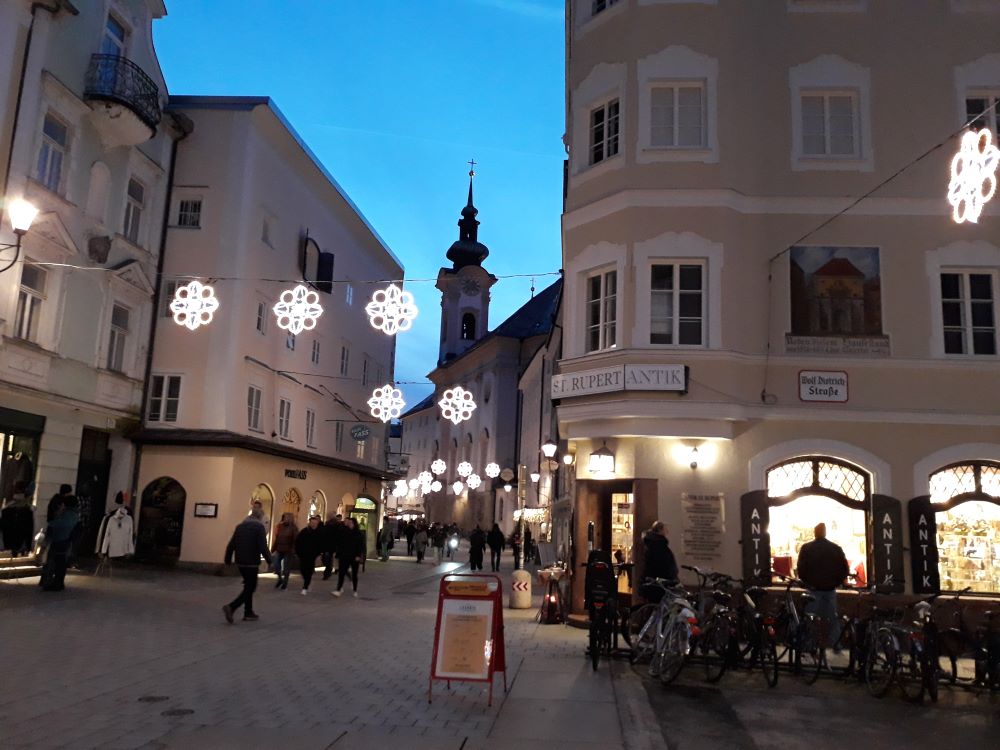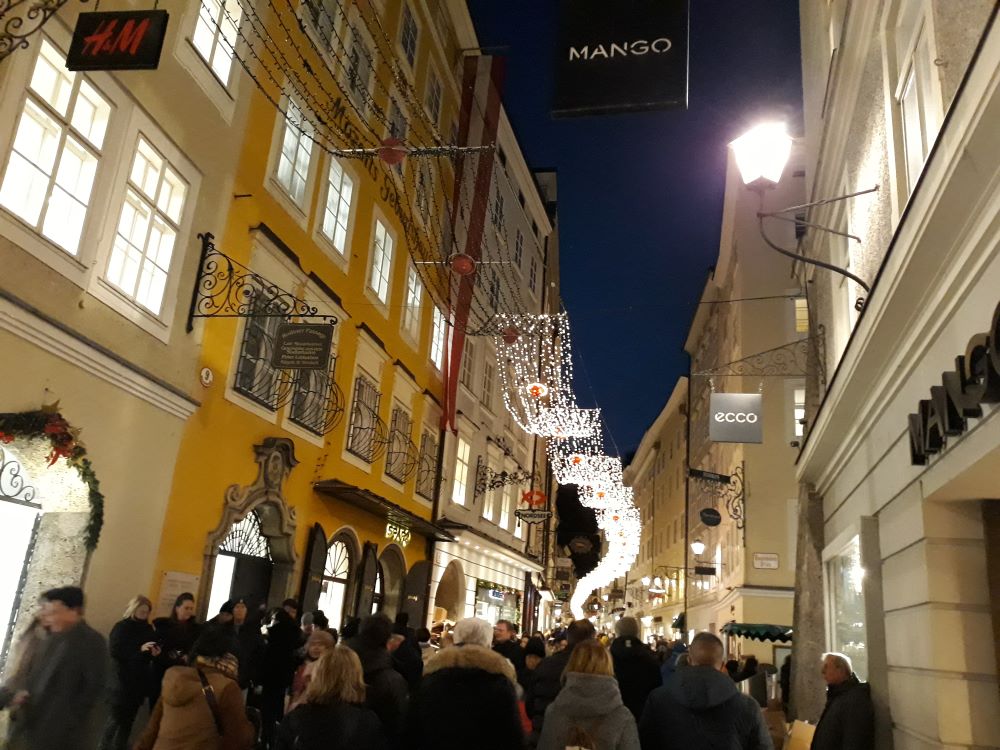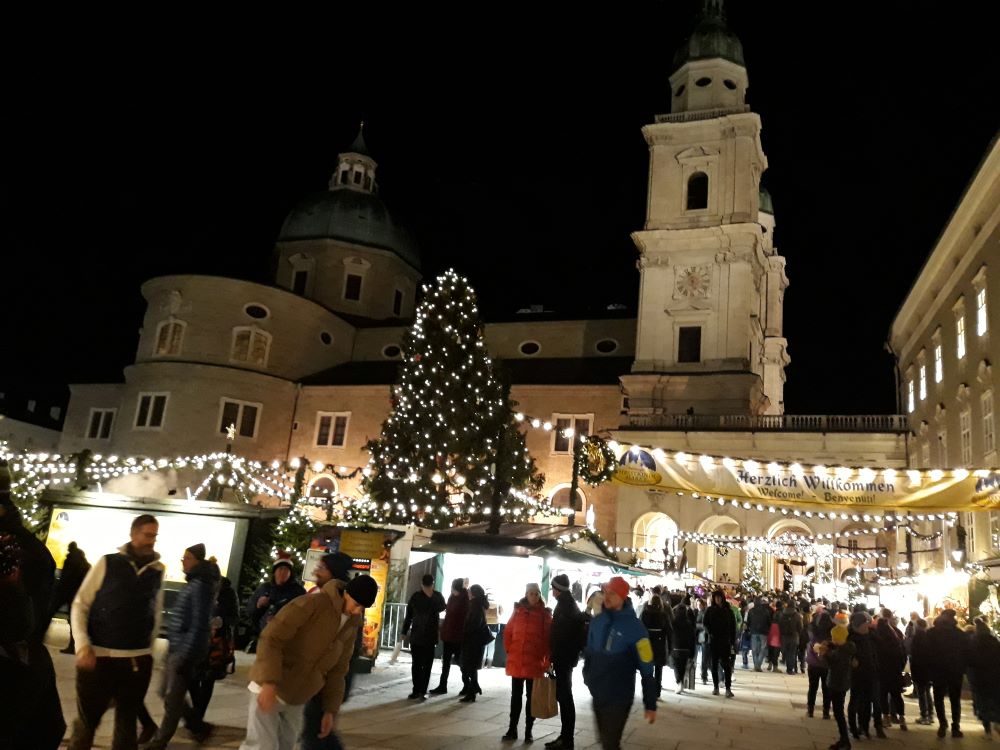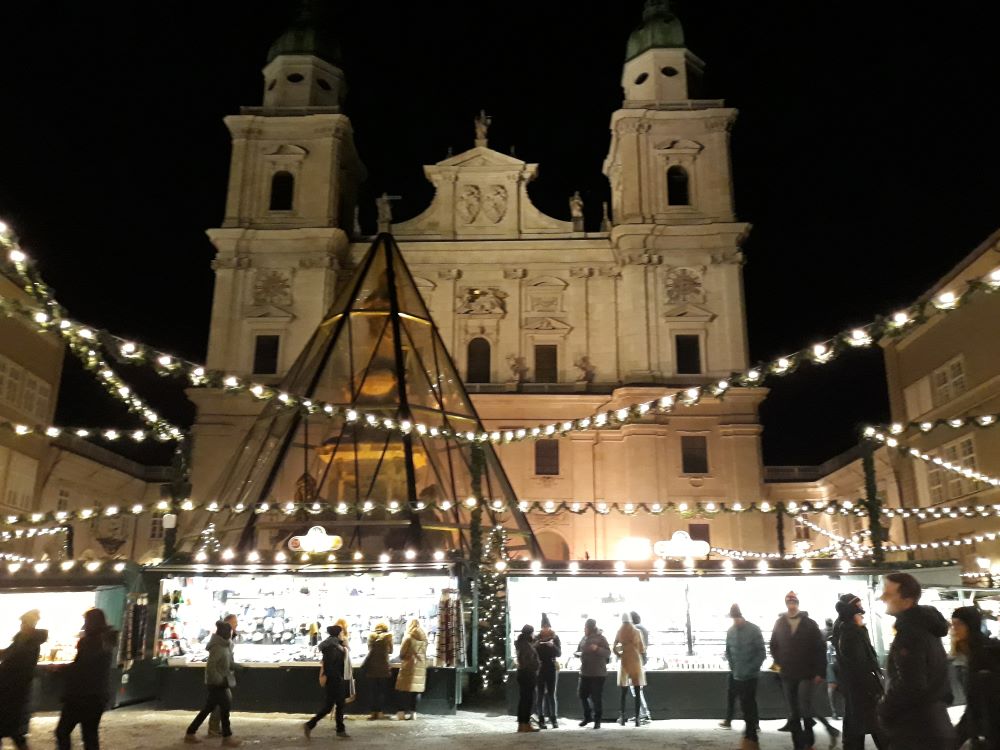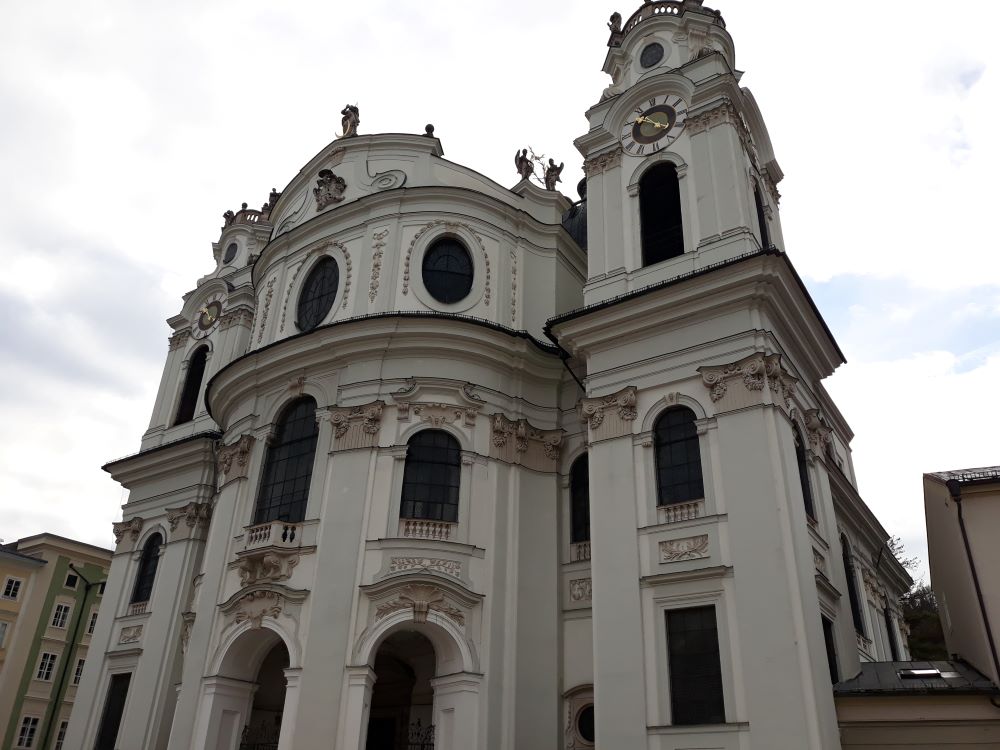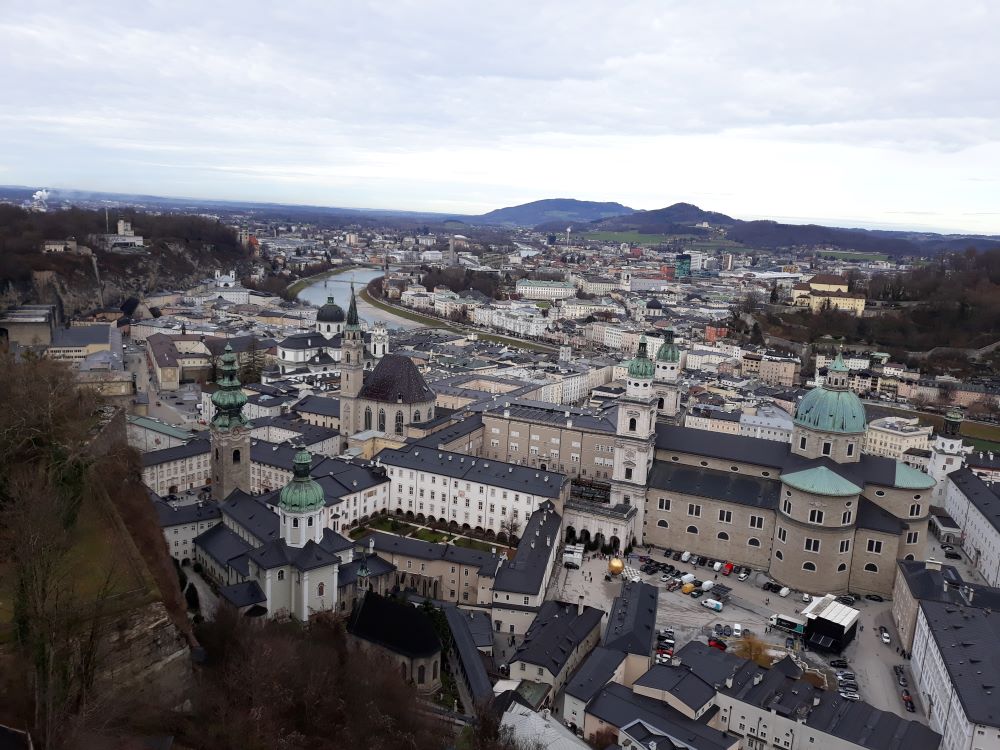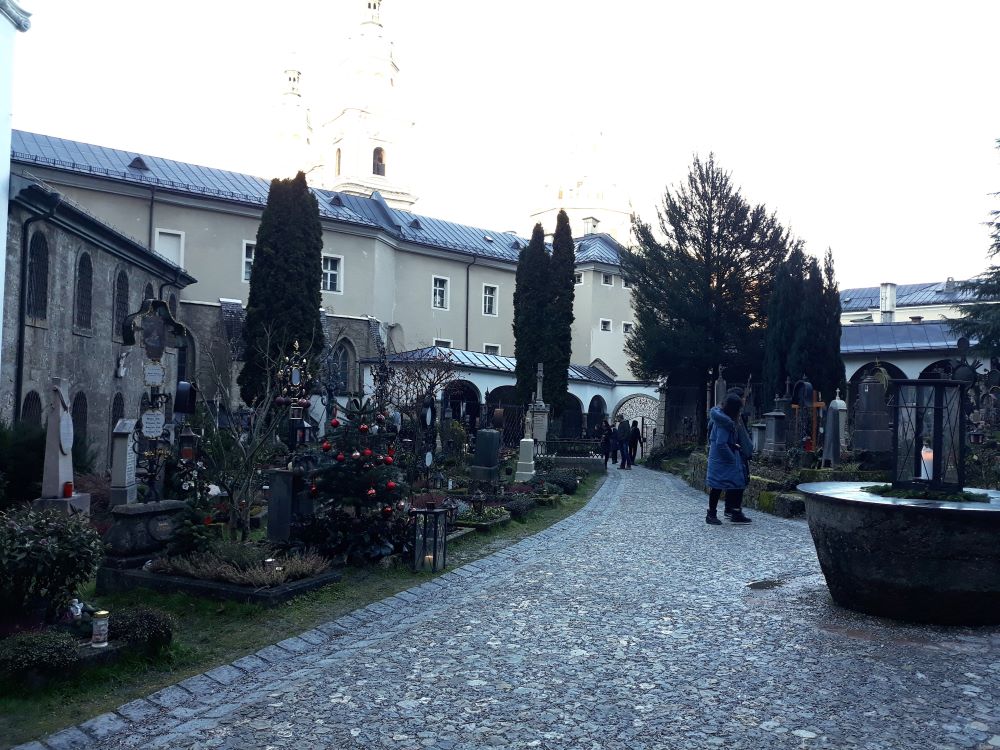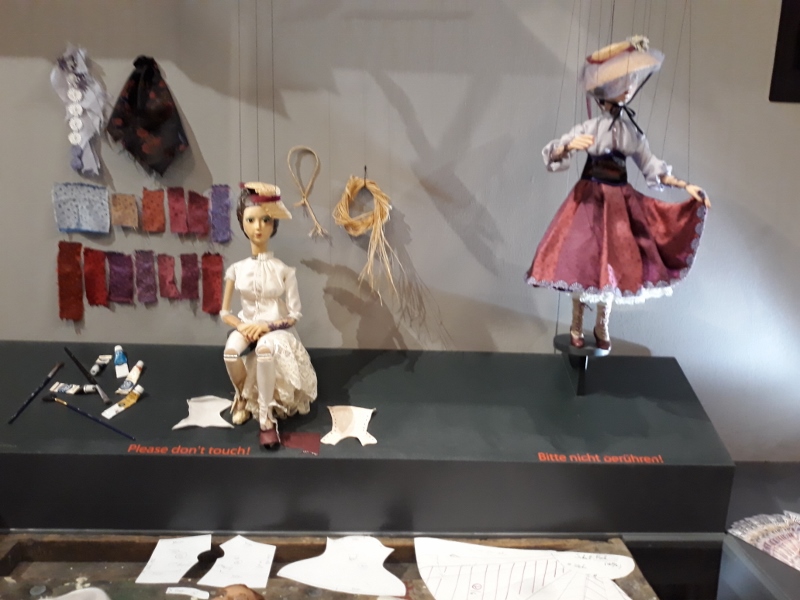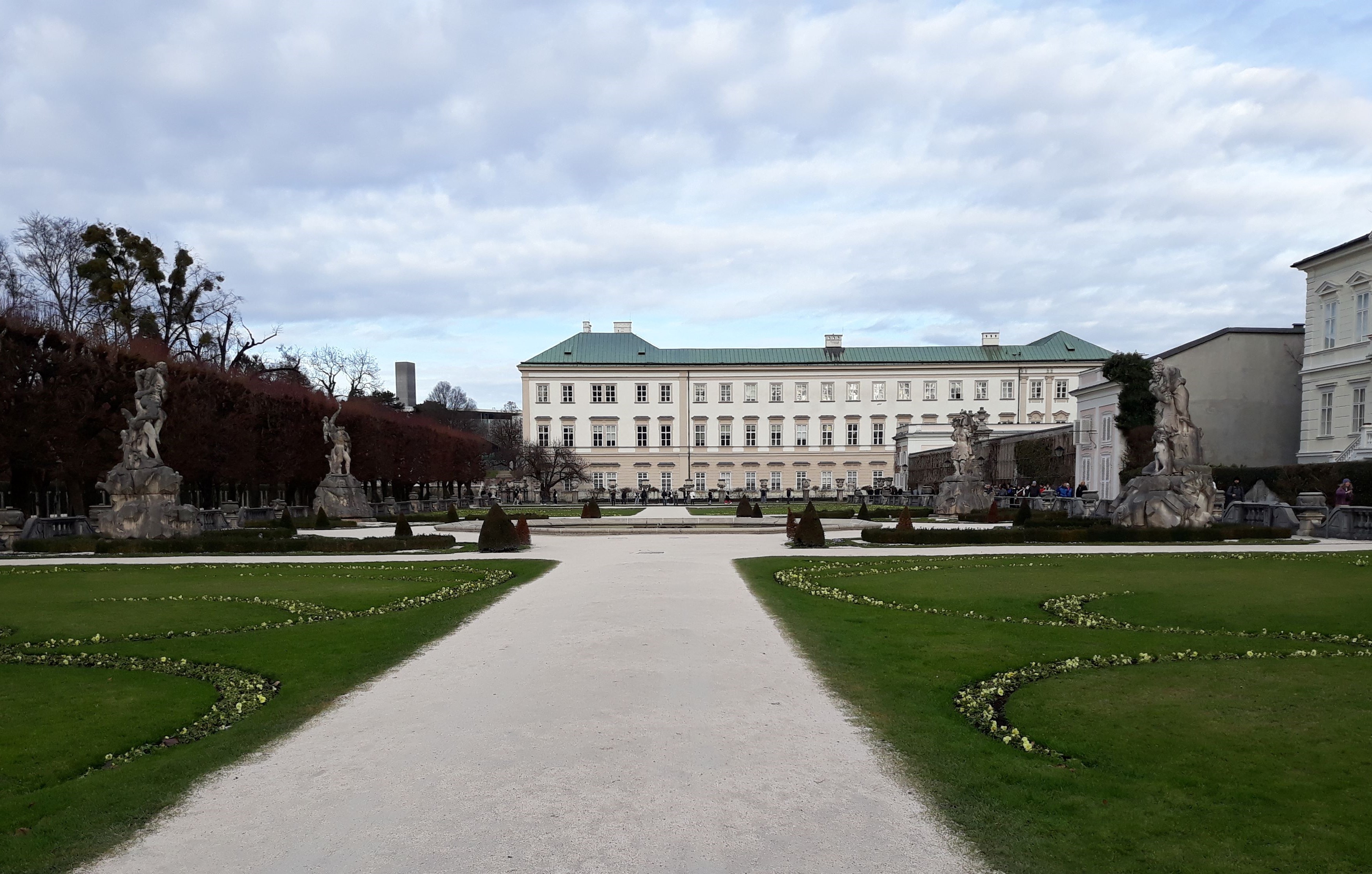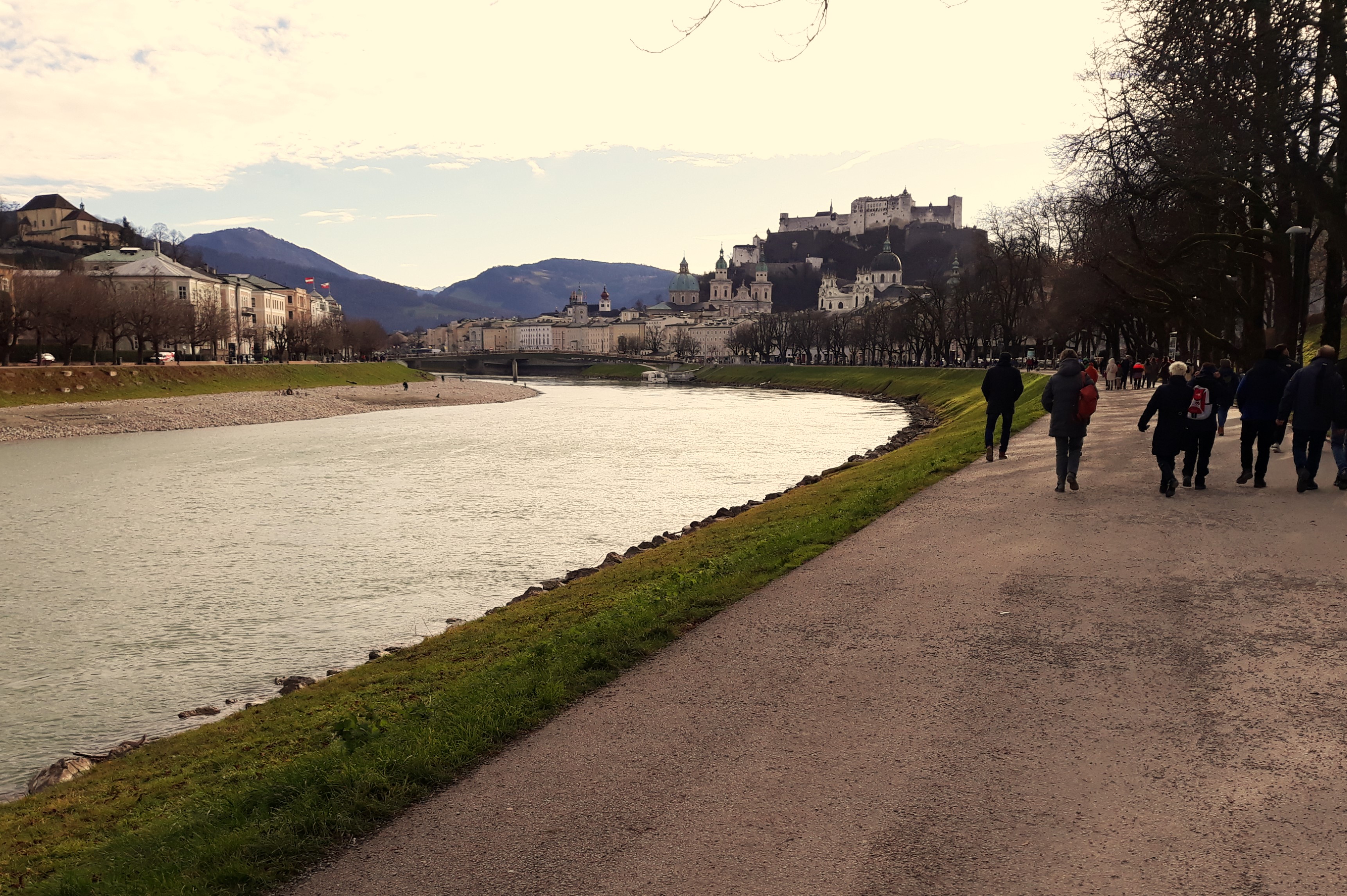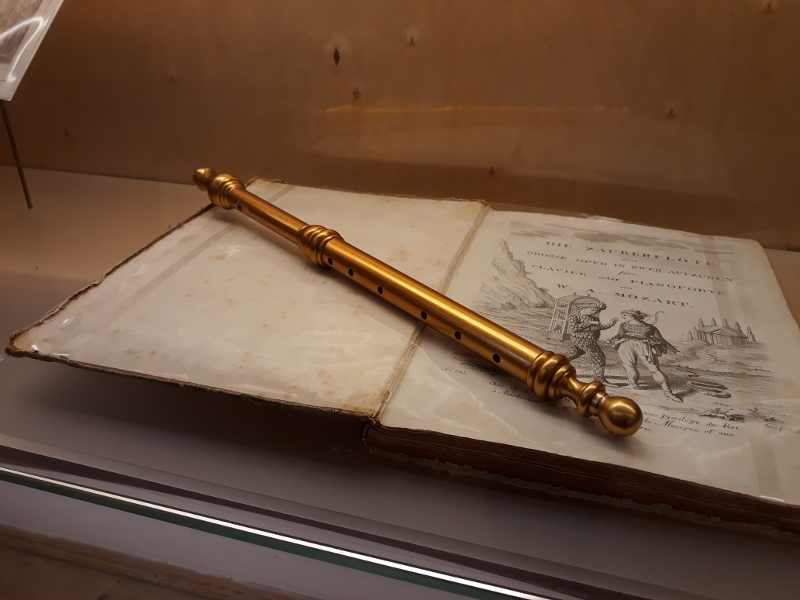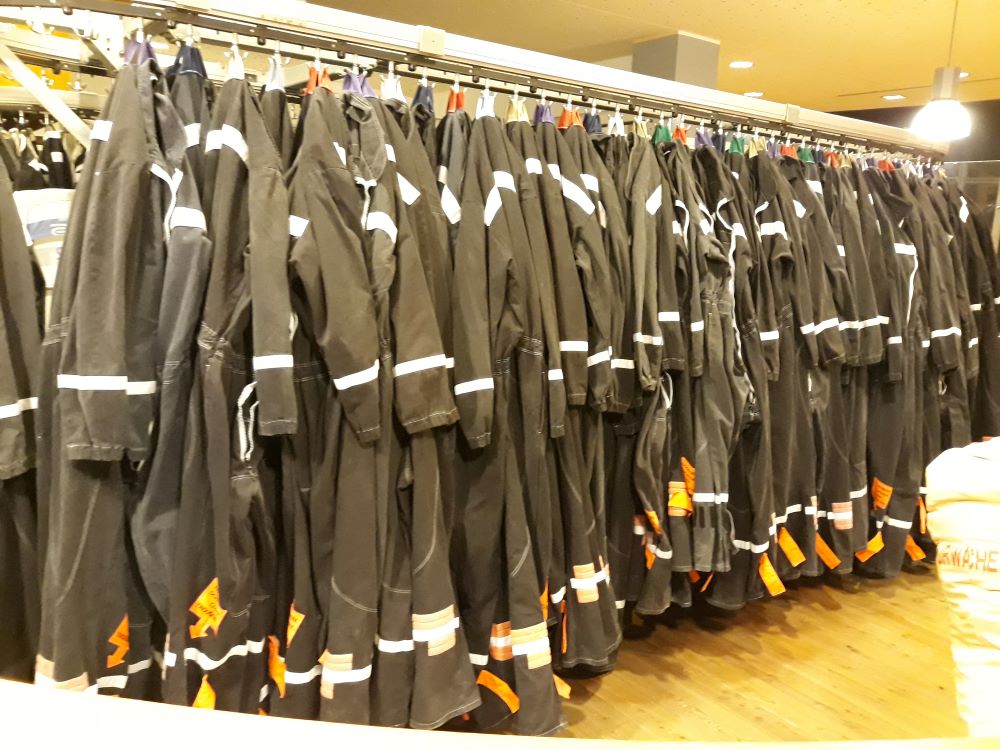27 – 30 dicembre 2022
Dopo gli anni difficili della pandemia, avevo proprio voglia di mettere nuovamente il naso fuori dall’Italia e respirare un po’ di atmosfera internazionale! Non mi azzardavo ancora ad intraprendere lunghi viaggi, così ho scelto di tornare a Salisburgo, dove ero stata molti anni prima, e che desideravo rivedere.
Salzburg at Christmas
27-30 December 2022
After the hard times of the pandemic, I was really longing for stepping out of Italy again and feeling some international atmosphere! I still didn’t dare set off on long trips, so I chose to return to Salzburg, where I had been many years before, and which I wanted to see again.
Questa elegante cittadina austriaca è situata vicino al confine con la Germania, incorniciata dalle Alpi orientali. Con il suo sapore tipicamente nordico ed un’importante tradizione culturale legata alla musica ed al teatro, mi sembrava il luogo adatto per rivivere lo spirito di festa del Natale che in quest’ultimo periodo era mancato.
This elegant Austrian town is located near the German border, framed by the Eastern Alps. Typically Nordic and culturally linked to the tradition of music and theatre, it seemed to me the right place to relive the festive Christmas time that had been missing in this last period.
Inizialmente pensavo di arrivare a Salisburgo in aereo, ma non ho trovato voli diretti dagli aeroporti di Venezia o Treviso, così ho optato per il treno. Alla stazione ferroviaria di Verona, presso l’ufficio delle ferrovie austriache, OBB, ho acquistato un biglietto ad un prezzo accettabile.
At first I thought of getting to Salzburg by plane, but I couldn’t find any direct flights from Venice or Treviso airports, so I opted for the train. At the Austrian railways office – OBB – in Verona train station, I bought a ticket at an acceptable price.
Nonostante Salisburgo non sia molto grande, vale la pena rimanerci tre notti per scoprire tutto ciò che essa offre, anche considerando che il viaggio in treno da Vicenza con i cambi dura circa sette ore. Le principali attrazioni turistiche sono comodamente raggiungibili a piedi, e comunque vi è anche un buon servizio di mezzi pubblici. Inoltre, fortunatamente qui si parla bene l’inglese un po’ ovunque!
Although Salzburg is not very big, it is worth staying there for three nights to discover everything it offers, also considering the seven hours’ train journey from Vicenza, including connections. The main tourist attractions are easily reachable on foot, anyway the public transport service is good too. Also, English is fortunately spoken well almost everywhere here!
27/12: sono giunta a Salisburgo alle 15. L’hotel era nel quartiere Schallmoos, sulla destra del fiume Salzach, ad una quindicina di minuti a piedi sia dalla stazione ferroviaria, sia dal centro. C’era il sole ed una buona temperatura, così mi sono subito incamminata lungo la Linzer Gasse, la via pedonale che conduce nella città vecchia. Qui ci sono negozi, pasticcerie e ristoranti, e le decorazioni natalizie mettevano già il buon umore! Salisburgo ha dato i natali al celebre compositore Wolfgang Amadeus Mozart, e molti sono i luoghi che lo ricordano e lo celebrano. Lungo la Linzer Gasse si trova la chiesa di San Sebastiano, in stile barocco, e sul retro il Cimitero con la tomba della famiglia Mozart.
27/12: I arrived in Salzburg at 3 pm. The hotel was in the Schallmoos district, on the right side of the Salzach river, about fifteen minutes’ walk from both the train station and the centre. It was sunny and the temperature was good, so I walked straight along Linzer Gasse, the pedestrian street that leads to the old town. Here there are shops, pastry shops and restaurants, and the Christmas decorations were already putting me in a good mood! Salzburg was the birthplace of the famous composer Wolfgang Amadeus Mozart, and many places remind of and celebrate him. Along the Linzer Gasse, San Sebastiano’s church in baroque style, has at its back a cemetery with the tomb of the Mozart family.
Attraversato il ponte Staatsbrücke, si giunge sulla sinistra della Salzach, dove sorge il centro storico con le vie pittoresche e gli edifici medioevali e barocchi. La Getreidegasse, la via principale della città vecchia, era affollata nell’ora del passeggio; le luci natalizie e le insegne decorate dei negozi illuminavano a giorno i palazzi del ‘700 e ‘800 dai bei portoni ed i cornicioni bianchi. Nonostante io abbia visto innumerevoli mercatini natalizi, sentivo la nostalgia della loro allegria, dei loro colori e profumi, e così mi sono addentrata nei cortili interni e nelle viuzze laterali della Getreidegasse, addobbati da bancarelle, alberi di Natale e renne.
After crossing the Staatsbrücke bridge, you reach the left side of the Salzach, and you are in the old town with its picturesque streets and its medieval and baroque buildings. Getreidegasse, the main street of the old town, was crowded at strolling time; the Christmas lights and decorated shop signs lit up the 18th and 19th century buildings with their beautiful doors and white frames. Although I have seen a great many Christmas markets, I was missing their joy, their colours and smells, and so I walked into the internal courtyards and side streets of Getreidegasse, ornated with stalls, Christmas trees and reindeer.
Salisburgo ha goduto fin dal ‘200 di un prestigio culturale ed economico grazie alla presenza del principato arcivescovile, che qui ha regnato già dai tempi di Carlo Magno, e che nel corso dei secoli ha conferito alla città l’attuale aspetto. Una figura importante è stata quella dell’arcivescovo Wolf Dietrich.
Salzburg enjoyed cultural and economic prestige since the 13th century thanks to the presence of the archiepiscopal principality; they reigned here since the times of Charlemagne, giving the city its current appearance over the centuries. An important personality was that of Archbishop Wolf Dietrich.
Residenzplatz è la più grande piazza della città, fatta costruire da lui a cavallo tra il ‘500 ed il ‘600. Al suo centro la fontana con i cavalli, i giganti ed i delfini, è visibile a stento, circondata dalle casette dei mercatini. Sul lato est vi è quella che fu la Residenza dell’Arcivescovo fino al XIX secolo, con le sue sale di gala ed una galleria di quadri dal ‘500 all’800. Nella piazza troneggia anche un lato del Duomo barocco con l’imponente cupola.
Residenzplatz is the largest square in the city, built by him between the 16th and 17th centuries. In its centre the fountain with horses, giants and dolphins is barely visible, surrounded by the market huts. On the east side there is what once was the Archbishop’s Residence until the 19th century, with its gala rooms and a gallery of paintings from the 16th to the 19th century. One side of the baroque Cathedral with its imposing dome also dominates the square.
Attraverso le arcate del Duomo si giunge in piazza Duomo: la sontuosa facciata in marmo e le torri laterali si ergono dietro ai banchetti e di sera il loro colore bianco rischiara la piazza in contrasto con il cielo scuro. Numerose statue ornano il Duomo, tra cui quelle dei patroni della città Ruperto e Virgilio. Anche l’interno è sfarzoso, con stucchi e dipinti di artisti italiani e tre altari in marmo.
Through the arches of the Cathedral you get to Piazza Duomo: the sumptuous marble facade and the side towers stand behind the stalls and in the evening their white colour lights up the square in contrast with the dark sky. Lots of statues adorn the Cathedral, including those of Rupert and Virgil city patrons. The interior is also opulent, with stuccoes and paintings by Italian artists and three marble altars.
Chi vuole scoprire la storia di Salisburgo ed è amante dell’arte, può effettuare la visita del DomQuartier: questo percorso inizia nei saloni di gala della Residenza, attraversando poi la galleria della Residenza, il Museo del Duomo ed il Museo di San Pietro.
Those who want to discover the history of Salzburg and are art lovers can visit the DomQuartier: a tour starting in the gala halls of the Residence, then through the Residence gallery, the Cathedral Museum and St. Peter’s Museum.
28/12: un po’ più freddo del giorno prima, ma una giornata di sole. Per prima cosa ho acquistato presso l’hotel la Salzburg Card, che comprende gli ingressi nelle maggiori attrazioni della città; io ho scelto quella di 48 ore, ma si può anche optare per una durata più breve o più lunga.
28/12: a little colder than the day before, yet a sunny day. First I bought the Salzburg Card at the hotel, which includes admission to the city’s major attractions; I chose the 48 – hour one, but you can also opt for a shorter or longer duration.
Nel centro di Salisburgo ci sono numerose chiese notevoli oltre al Duomo, così stamattina ho iniziato la visita con la Kollegienkirche in piazza dell’Università: a malapena ho potuto inquadrare per intero questo edificio in tutta la sua grandezza, uno dei più importanti esempi di barocco austriaco. Fu costruita a cavallo tra il ‘600 ed il ‘700 e donata all’Università. All’esterno essa presenta la facciata centrale dalla particolare forma curva. All’interno, le pareti bianche e la grande cupola centrale creano un effetto di ampio spazio, e si trovano i quadri dei patroni dell’Università S. Borromeo e S. Benedetto.
In the centre of Salzburg there are many notable churches, as well as the Cathedral, so this morning I started the visit with the Collegiate Church in University Square: I could hardly fully frame this building in all its grandeur, one of the most important examples of Austrian Baroque. It was built between the 17th and 18th centuries and donated to the University. On the outside it has a central peculiar curved façade. Inside, the white walls and the large central dome make it look large, and there are paintings of the University patrons S. Borromeo and S. Benedetto.
Un simbolo di Salisburgo è la Fortezza Hohensalzburg, una delle maggiori rocche d’Europa. Essa sovrasta la città dall’alto del monte Festungsberg: si può raggiungere a piedi, ma io ho scelto la via più comoda e veloce, la funivia! La costruzione di questa fortezza a scopo difensivo risale al 1077, con l’arcivescovo Gebhard. Nel corso dei secoli essa fu ampliata e subì numerosi assedi, ma non fu mai conquistata, fino al 1861 quando perse la sua funzione difensiva. Nel cortile interno vi è la Cappella di San Giorgio e, su una parete esterna, un monumento a Leonhard von Keutschbach, l’arcivescovo che nel 1500 fece adornare le stanze in modo elegante.
A symbol of Salzburg is the Hohensalzburg Fortress, one of the largest fortresses in Europe overlooking the city from the top of Mount Festungsberg. You can reach it on foot, but I chose the most convenient and fastest way, the cable car! The construction of this fortress for defensive purposes dates back to 1077, with Archbishop Gebhard. Over the centuries it was enlarged and underwent lots of sieges, but it was never conquered, until 1861 when it lost its defensive function. In the internal courtyard there is St. George’s Chapel and, on an external wall, a monument to Leonhard von Keutschbach, the archbishop who had the rooms elegantly adorned in the 1500s.
La fortezza offre una bella vista sulla città, il cui profilo è caratterizzato dalle cupole e dalle torri delle chiese: a sinistra la Chiesa di San Pietro, la Chiesa dei Francescani con la torre a punta gotica, e più a sinistra verso il fiume, la cupola della Collegiata; sulla destra invece, la cupola e le torri del Duomo.
The fortress offers a beautiful view over the city skyline, marked by the domes and towers of the churches: on the left St Peter’s Church, the Franciscan Church with the Gothic pointed tower, and further to the left towards the river, the dome of the Collegiate Church; on the right, the dome and towers of the Cathedral.
Inside you can then visit the princely rooms, including the Golden Room, the Reiner Regiment Museum and the Fortress Museum.
Al termine della visita, non perdetevi il piccolo Museo delle Marionette: qui sono rappresentate la rivolta dei contadini del 1525, uno degli assedi più memorabili alla fortezza, e la famiglia von Trapp del celebre film musicale Tutti insieme appassionatamente (The Sound of Music), ambientato proprio a Salisburgo.
At the end of the visit, don’t miss the small Puppet Museum: here the peasants’ revolt of 1525 is represented, one of the most memorable sieges of the fortress, and the von Trapp family from the famous musical film The Sound of Music, set right in Salzburg.
Nel pomeriggio, dopo la visita all’interno del Duomo, sono andata alla Chiesa Conventuale di San Pietro, appartenente all’omonima abbazia benedettina fondata nel 696 da S. Ruperto; in origine una basilica romanica, essa venne poi rifatta in stile rococò e presenta un interno sontuoso. Essa custodisce la tomba rupestre di S. Ruperto, patrono della città. Il cimitero di San Pietro è suggestivo con le sue croci sepolcrali, le tombe di illustri famiglie di Salisburgo, e le Catacombe, cappelle scavate sulla parete del monte Monchsberg, probabilmente utilizzate da una comunità di monaci. Nella fossa comunale del Cimitero è sepolta la sorella di Mozart, Maria Anna.
In the afternoon, after the visit inside the Cathedral, I went to St Peter’s Conventual Church, belonging to the homonymous Benedictine abbey founded in 696 by St. Rupert; originally a Romanesque basilica, it was later rebuilt in rococo style and has a sumptuous interior. It houses St Rupert’s rock tomb. St Peter’s cemetery is evocative with its sepulchral crosses, the tombs of illustrious Salzburg families, and the Catacombs, chapels dug into the side of Mount Monchsberg, probably used by a community of monks. Mozart’s sister, Maria Anna, is buried in the municipal grave of the cemetery.
After the cultural visits, some lightness was needed, and so I spent a pleasant half hour in the Christmas museum. It is small, but full of atmosphere especially at this time of year, with many objects that represent Austrian Christmas traditions over a period of 100 years, from 1840 to 1940: from markets, to Advent calendars, to the characters of Krampus and Saint Nicolaus.
The museum is in Piazza Mozart above a café restaurant called Glockenspiel, or carillon: it takes its name from the carillon on the tower of the Residenza Nuova building, which rings three times a day. In the square there is a monument to Mozart, a bronze statue celebrating the composer. In winter an ice skating rink there attracts adults and children.
A “social” evening awaited me, as I had booked The Magic Flute show by Mozart – Die Zauberflöte -, in the enchanting Puppet Theatre. I had purchased the ticket online three weeks before departure, and the paper copy arrived by mailt a few days later.
La tradizione di questo teatro è iniziata nel 1913, ed oggi esso è situato in un elegante edificio barocco; quando si entra nell’atrio, le marionette in esposizione, con i loro vestiti colorati, trasportano già in una dimensione di fiaba. Ero molto affascinata da questo genere di spettacolo che non avevo mai visto prima. In realtà, ben presto ci si dimentica che sono dei burattini, tanto hanno delle sembianze umane e dei movimenti naturali, grazie a coloro che, dall’alto del palcoscenico, li manovrano.
The tradition of this theatre began in 1913, and today it is located in an elegant baroque building; when you enter the foyer, the puppets on display, in their colourful clothes, soon take you to a fairytale dimension. I was very attracted to this kind of show I had never seen before. Actually, you’ll soon forget that they are puppets, as their features look so human and their movements so natural, thanks to those who operate them from the top of the stage.
Gli spettacoli diventano, così, vere e proprie opere d’arte, tanto da appartenere alla Lista del Patrimonio Culturale Immateriale dell’Unesco. Le rappresentazioni sono in lingua tedesca, ma sulle pareti laterali della sala si possono leggere i sottotitoli in inglese ed altre lingue. Qui vengono rappresentate anche altre fiabe famose nel mondo: Hansel & Gretel, lo Schiaccianoci, il Piccolo Principe.
The shows thus become true works of art, so that they belong to the UNESCO List of Intangible Cultural Heritage. The performances are in German language, but on the side walls of the room you can read subtitles in English and other languages. Other world famous fairy tales are also performed here: Hansel & Gretel, the Nutcracker, the Little Prince.
29/12: Oggi era piuttosto freddo, così ho preferito prendere l’autobus, alla fermata vicino all’albergo, per andare al castello di Mirabell, poco lontano dal centro storico. Esso fu fatto costruire all’inizio del 1600 dall’arcivescovo Wolf Dietrich per la sua amante Salome Alt; il nome Mirabell, dal latino “mirabilis”, venne dato dal nipote suo successore. Salendo la Scala degli Angeli, in stile rococò e decorata con numerosi putti e statue di divinità e figure mitologiche, si giunge alla Sala dei Marmi: un tempo essa era adibita alle feste, oggi ospita convegni e concerti, e vi si celebrano matrimoni.
29/12: Today it was rather cold, so I preferred to take the bus, at the stop near the hotel, to Mirabell castle, not far from the old town. It was built at the beginning of 1600 by Archbishop Wolf Dietrich for his lover Salome Alt; the name Mirabell, from the Latin “mirabilis”, was given by his successor grandson. Going up the Angels’ Stair, in rococo style and decorated with lots of cherubs and statues of deities and mythological figures, you reach the Marble Hall: once it was used for parties, today it hosts conferences and concerts, and weddings are celebrated there.
Il giardino barocco del castello, offre una bella vista sul duomo e sulla fortezza: esso è adornato da vasi in marmo e statue di divinità, oltre che dalla fontana di Pegaso e dalla fontana ottagonale centrale. Vi è anche un giardino degli gnomi, ma nel periodo invernale esso è purtroppo chiuso.
The baroque garden of the castle offers a beautiful view of the cathedral and the fortress: it is adorned with marble vases and statues of deities, as well as the Pegasus fountain and the central octagonal fountain. There is also a gnome garden, but unfortunately it is closed in winter.
Al termine della visita ho attraversato il ponte Müllnersteg, situato all’altezza del castello, e sono tornata verso la città vecchia passeggiando lungo il fiume Salzach, ammirando il bel panorama delle montagne circostanti ed una visione d’insieme della città.
At the end of the visit I crossed the Müllnersteg bridge, at the height of the castle, and walked back to the old city along the Salzach river, admiring the beautiful panorama of the surrounding mountains and an overall view of the city.
La mia prossima destinazione era la casa più famosa della Getreidegasse, al n. 9, la casa natale di Mozart: non si può non notarla per il suo colore giallo acceso e per le numerose persone in fila davanti ad essa. Qui la famiglia Mozart abitò in un appartamento al terzo piano dal 1747 al 1773, e nel 1756 vi nacque Wolfagang Amadeus. La casa è oggi un museo che custodisce gli strumenti originali del musicista – un pianoforte, un clavicordo ed un violino – degli scritti autografi che documentano la sua vita e dei dipinti che rappresentano le sceneggiature delle sue opere.
My next destination was the most famous house at 9, Getreidegasse, Mozart’s birthplace: it stands out for its bright yellow colour and for the numerous people queuing in front of it. Here the Mozart family lived in an apartment on the third floor from 1747 to 1773, and in 1756 Wolfagang Amadeus was born there. The house is now a museum that houses the musician’s original instruments – a piano, a clavichord and a violin – autograph writings documenting his life and paintings representing the scripts of his works.
Nel 1773 la famiglia si trasferì in piazza Makart: l’abitazione fu quasi completamente distrutta durante la II guerra mondiale ed oggi rimane una piccola parte adibita a museo. Poco lontano vi sono il Landestheater, il Teatro delle Marionette ed il Mozarteum, che ospita due sale per concerti e la Biblioteca Mozartiana.
In 1773 the family moved to Makart Square: the house was almost completely destroyed during World War II and today the remaining small part is a museum. Not far away are the Landestheatre, the Puppet Theatre and the Mozarteum, which houses two concert halls and the Mozart Library.
Salisburgo, come anche il fiume Salzach, prende il nome dall’ importante commercio dell’estrazione del sale. Le miniere di salgemma situate nelle montagne circostanti costituivano una risorsa preziosa già dal ‘400 a.C., quando i Celti si dedicavano a questa attività. Consiglio una visita ad una di esse per conoscere il processo di estrazione di questo “oro bianco”, come il sale era definito, ed il disagevole lavoro dei minatori.
Salzburg, like the Salzach River, takes its name from the important trade of salt extraction. The rock salt mines located in the surrounding mountains were a precious resource as early as 400 BC, when the Celts had this job. I recommend a visit to one of them to learn about the extraction process of this “white gold”, as salt was defined, and the uncomfortable work of the miners.
Nei dintorni di Salisburgo vi è la miniera di Hallein, io però ho scelto di visitare quella di Berchtesgaden in Germania, poco dopo il confine, poiché era più semplice da raggiungere con i mezzi pubblici. L’autobus 840 porta in una mezz’ora dal centro di Salisburgo a Berchtesgaden e si scende alla fermata di Salzbergwerk. Le corse sono abbastanza frequenti.
The Hallein mine is near Salzburg, but I chose to visit the Berchtesgaden mine in Germany, shortly after the border, since it was easier to reach by public transport. Bus 840 takes you directly from the centre of salzburg to Berchtesgaden in half an hour, and you get off at Salzbergwerk stop. The trips are quite frequent.
La temperatura interna alla miniera è di circa 12 gradi: occorre avere abiti pesanti, sopra cui indossare la “tuta da minatore”, prima di addentrarsi nel cuore delle Alpi di Berchtesgaden a bordo di un trenino. Due scivoli conducono poi in profondità per scoprire tutto sull’attività di estrazione, iniziata nel 1517, e tuttora in essere. I luoghi più suggestivi sono la Cattedrale del Sale ed il Lago degli Specchi, dove si effettua un breve giro in barca. Si vedono anche un filmato didattico ed uno spettacolo di luci. Si risale in superficie a bordo di un ascensore inclinato. Una visita interessante, ma anche una divertente esperienza per grandi e bambini!
The temperature inside the mine is around 12 degrees: warm clothes are needed, on which you have to wear the “miner’s overalls”, before boarding a train into the heart of the Berchtesgaden Alps. Down two slides into the depths, you’ll discover everything about the extraction work, which began in 1517 and is still ongoing today. The most suggestive places are the Salt Cathedral and the Lake of Mirrors, where you can take a short boat ride. You can also see an educational film and a light show. You go up to the surface aboard an inclined lift. An interesting visit, as well as a fun experience for adults and children!
Anche questa giornata è stata bella intensa e, dopo un po’ di riposo in camera, ho gustato un’abbondante cena alla Urbankeller, una tipica locanda a dieci minuti a piedi dall’hotel: Wienerschnitzel, la cotoletta impanata tipica della cucina viennese, con contorno di patate e marmellata di ribes!
This day too was full, and after resting a while in the room, I enjoyed a big dinner at the Urbankeller, a typical inn ten minutes’ walk from the hotel: Wienerschnitzel, the breaded cutlet typical of Viennese cuisine, with potatoes and blackcurrant jam aside!
30/12: oggi soleggiato e più caldo dei giorni scorsi, che peccato tornare a casa! In autobus sono andata in stazione, dove ho preso il treno alle 11 con cambio ad Innsbruck e Verona, ed alle 18 ero a Vicenza. Il treno, sia all’andata che al ritorno, era affollato di turisti, ed anche a Salisburgo c’era un bel movimento che ha contribuito a rendere il clima ancora più piacevole. Un segnale positivo di ripresa e di voglia di tornare a viaggiare.
30/12: today sunny and warmer than previous days, what a shame to go home! By bus I went to the station, where I took the train at 11am with changes in Innsbruck and Verona, and at 6pm I was in Vicenza. The train, both on the outward and return journey, was crowded with tourists, and also Salzburg was lively, which made the ambience even more pleasant. A positive sign of recovery and desire to travel again.
Articoli correlati – related articles: Christmas time in Vienna
